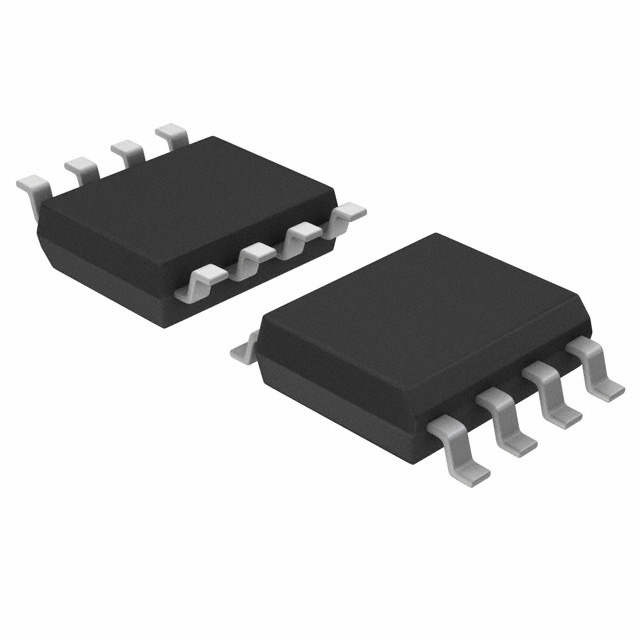PCA9550D,118
Product Overview
Category
The PCA9550D,118 belongs to the category of integrated circuits (ICs).
Use
This product is primarily used for input/output (I/O) expansion in various electronic devices and systems.
Characteristics
- I2C-bus interface compatibility
- 8-bit remote I/O port with interrupt capability
- Low standby current consumption
- Schmitt-trigger action on all inputs
- Open-drain interrupt output
- Noise filter on SDA/SCL inputs
- Latched outputs with high-current drive capability
- ESD protection exceeds JESD 22
Package
The PCA9550D,118 is available in a small outline package (SOT96-1), also known as a Thin Shrink Small Outline Package (TSSOP).
Essence
The essence of the PCA9550D,118 lies in its ability to provide additional I/O ports for electronic devices, enabling efficient communication and control between different components.
Packaging/Quantity
This product is typically packaged in reels, with each reel containing a specific quantity of PCA9550D,118 ICs. The exact quantity per reel may vary depending on the manufacturer's specifications.
Specifications
- Supply voltage range: 2.3 V to 5.5 V
- Input voltage range: 0 V to VDD
- Output voltage range: 0 V to VDD
- Operating temperature range: -40°C to +85°C
- Maximum clock frequency: 400 kHz
- Maximum I/O sink/source current: ±10 mA
Detailed Pin Configuration
The PCA9550D,118 features a total of 16 pins, each serving a specific purpose. The pin configuration is as follows:
- A0: Address input bit 0
- A1: Address input bit 1
- A2: Address input bit 2
- GND: Ground
- SDA: Serial data input/output
- SCL: Serial clock input
- INT: Interrupt output
- P0-P7: I/O ports 0 to 7
Functional Features
- I2C-bus interface compatibility allows easy integration into existing systems.
- Schmitt-trigger action on all inputs ensures reliable signal processing, even in the presence of noise.
- Open-drain interrupt output enables efficient communication with external devices.
- Latched outputs with high-current drive capability facilitate control of various components.
- ESD protection exceeds JESD 22 standards, ensuring robustness against electrostatic discharge.
Advantages and Disadvantages
Advantages
- Compact size and low standby current consumption make it suitable for space-constrained applications.
- Compatibility with the I2C-bus interface simplifies integration into existing systems.
- Schmitt-trigger action enhances noise immunity, ensuring reliable operation.
- High-current drive capability allows direct control of power-hungry components.
Disadvantages
- Limited number of I/O ports may restrict its use in applications requiring a large number of connections.
- The maximum clock frequency of 400 kHz may limit the speed of data transfer in certain scenarios.
Working Principles
The PCA9550D,118 operates based on the I2C-bus protocol, which enables communication between different ICs using a two-wire serial interface. It acts as an I/O expander by providing additional ports that can be controlled and monitored through the I2C-bus interface. The device receives commands and data from the master device via the SDA and SCL lines, and performs the specified operations on the I/O ports accordingly.
Detailed Application Field Plans
The PCA9550D,118 finds application in various fields where additional I/O ports are required. Some potential application areas include:
- Home automation systems: The device can be used to expand the number of controllable devices, such as lights and appliances.
- Industrial control systems: It enables efficient control and monitoring of multiple sensors and actuators.
- Automotive electronics: The PCA9550D,118 can be utilized for I/O expansion in automotive applications, such as controlling lighting systems or interfacing with external sensors.
Detailed and Complete Alternative Models
- PCA9550PW,112: Similar to PCA9550D,118 but available in a different package (TSSOP20).
- PCA9550BS,118: Offers the same functionality as PCA9550D,118 but comes in a smaller package (SOT23-6).
These alternative models provide similar features and can be considered as substitutes based on specific requirements and constraints.
In conclusion, the PCA9550D,118 is an integrated circuit that serves as an I/O expander, providing additional ports for communication and control purposes. Its compatibility with the I2C-bus interface, low standby current consumption, and high-current drive capability make
Senaraikan 10 soalan dan jawapan biasa yang berkaitan dengan aplikasi PCA9550D,118 dalam penyelesaian teknikal
Sure! Here are 10 common questions and answers related to the application of PCA9550D,118:
Question: What is PCA9550D,118?
Answer: PCA9550D,118 is a 16-bit I/O expander with an I2C interface, which allows for easy expansion of GPIO (General Purpose Input/Output) pins in technical solutions.Question: How many GPIO pins does PCA9550D,118 provide?
Answer: PCA9550D,118 provides 16 GPIO pins that can be configured as either inputs or outputs.Question: What is the maximum voltage that PCA9550D,118 can handle?
Answer: PCA9550D,118 can handle a maximum voltage of 5.5V.Question: Can PCA9550D,118 be used with both 3.3V and 5V microcontrollers?
Answer: Yes, PCA9550D,118 is compatible with both 3.3V and 5V microcontrollers.Question: How do I communicate with PCA9550D,118 using the I2C interface?
Answer: You can communicate with PCA9550D,118 by sending I2C commands and data through the SDA (Serial Data) and SCL (Serial Clock) lines.Question: Can PCA9550D,118 be used to drive LEDs?
Answer: Yes, PCA9550D,118 can be used to drive LEDs as it can sink up to 25mA per GPIO pin.Question: Is it possible to configure individual GPIO pins as inputs or outputs?
Answer: Yes, each GPIO pin on PCA9550D,118 can be individually configured as either an input or an output.Question: Can PCA9550D,118 be used in battery-powered applications?
Answer: Yes, PCA9550D,118 has a low standby current consumption, making it suitable for battery-powered applications.Question: What is the maximum frequency at which I can communicate with PCA9550D,118 over I2C?
Answer: PCA9550D,118 supports I2C communication speeds up to 400kHz.Question: Are there any additional features or functionalities of PCA9550D,118?
Answer: PCA9550D,118 also includes programmable output polarity inversion and internal power-on reset functionality.
Please note that these answers are general and may vary depending on the specific implementation and requirements of your technical solution.


